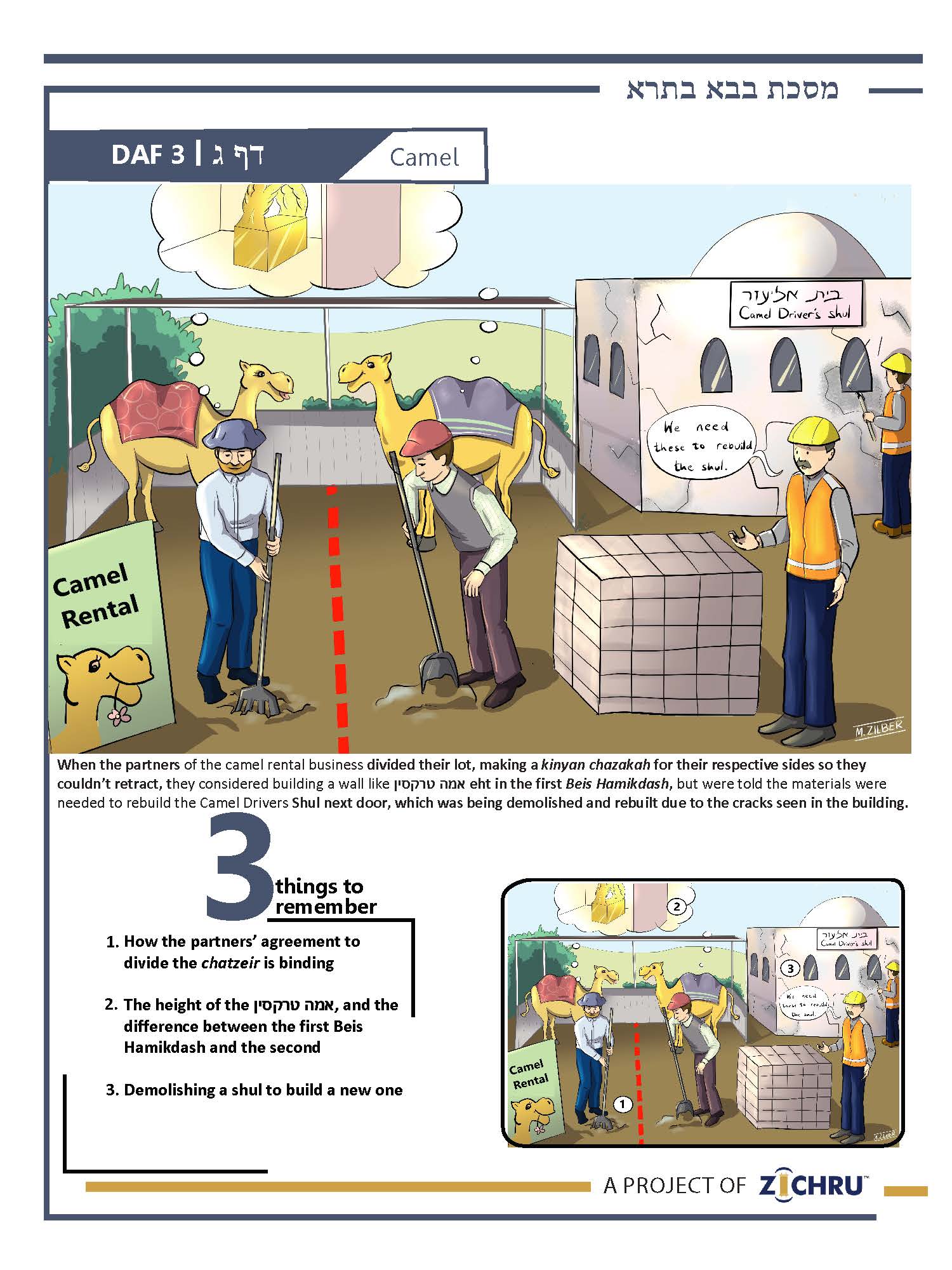Bava Basra - Daf 3
Audio Timestamps
0:00 - The 3 Sugyos
3:01 - Review of 3 Sugyos
5:49- Siman
8:19 - 4 Blatt Back Chazarah
16:20 - Pop Quiz (Last 7 blatt)
For access to all Zichru resources including PDFs, and illustrations CLICK HERE
- How the partners’ agreement to divide the chatzeir is binding
Rav Assi explained, in the Gemara’s second version, that the partners divided a property כשאין בה דין חלוקה – which was not subject to legal division, i.e., it was too small for either to demand a division, but they agreed to do so. The Gemara asks, נהדרו בהו – but let them retract, since a mere verbal agreement to divide the chatzeir is not binding!? Rebbe Yochanan explained: שקנו מידן – they acquired from each other with a legal kinyan, e.g. חליפין. The Gemara objects that it is קנין דברים בעלמא – an acquisition of mere words, i.e., an intangible commitment to divide the property, and so it clarifies: בשקנו מידן ברוחות – they acquired from each another the sides of the property which they would respectively own, and this acquisition is binding. Rav Ashi said: כגון שהלך זה בתוך שלו והחזיק – the case is where this one went into his half of the chatzeir and performed a kinyan chazakah, וזה בתוך שלו והחזיק – and this other one went into his half and performed a kinyan chazakah.
- The height of the אמה טרקסין, and the difference between the first Beis Hamikdash and the second
The Mishnah taught that a wall of גזית – planed stones which is four amos tall must be five tefachim wide. The Gemara wonders if this is the necessary ratio, because the אמה טרקסין (the wall separating the קדש from the קדש הקדשים in the first Beis Hamikdash) was thirty amos high, but only six tefachim wide!? The Gemara answers that the extra tefach was enough to support a much higher wall. Still, the second Beis Hamikdash did not have an אמה טרקסין, because six tefachim of width can only support thirty amos of height, but the second Beis Hamikdash was taller. The source that it was taller is from the passuk: גדול יהיה כבוד הבית הזה האחרון מן הראשון – the honor of this later House will be greater than that of the first. Amoraim debated its meaning; one said it means בבנין – in the structure, that it would be taller, and one said it means בשנים – in years of existence, because the second Beis Hamikdash stood for 420 years, ten years longer than the first. Although part of the height could have been built as a wall, and the rest as a paroches, there was a tradition that the divider must be either entirely a wall or a curtain, not a combination of the two.
- Demolishing a shul to build a new one
Rav Chisda said: לא ליסתור איניש בי כנישתא – a person may not demolish a shul עד דבני בי כנישתא אחריתי – until he has built another shul to replace it. Some say this is because of פשיעותא – negligence, that a new shul may not be built, and some explain it is because of צלויי – a place for davening in the interim. A practical difference between these reasons is if there is already another place available to daven. Rav Ashi ruled that even if funds were deposited for building, or even if construction materials were already set aside, we are still concerned they may be sold for funds necessary to redeem captives, and the shul will not be built. The Gemara qualifies Rav Chisda’s law: חזי בה תיוהא – if they see cracks in it and it may collapse, they may demolish it and then build another. Rav Ashi saw cracks in the shul in Masa Mechasya, and he demolished it, and brought his own bed there until the new construction was fully completed. Bava Ben Buta advised Herod to demolish the Beis Hamikdash and rebuild it, either because he saw cracks in it, or because a king can be relied upon to fulfill his commitment.
Siman – Camel
When the partners of the camel rental business divided their lot, making a kinyan chazakah for their respective sides so they couldn’t retract, they considered building a wall like the אמה טרקסין in the first Beis Hamikdash, but were told the materials were needed to rebuild the Camel Drivers Shul next door, which was being demolished and rebuilt due to the cracks seen in the building.


